#horror films where the monster is in some way also the female protagonist my beloved <3
Text
thinking about hatching (2022) again...
#ooooh that film#its like#my favourite genre of film in its most distilled form#like its not my no.1 film ever (although def top 5 atm)#but its sooooo#horror films where the monster is in some way also the female protagonist my beloved <3#ESPECIALLY when theyre coming of age#like yes give me everything#the monster as an inheritance the monster as a becoming the monster as a craving the monster as a mirror!!!!!!!!!!#pls i have half an essay written on this in my docs atm#raw (2016) is also very good for this#hatching 2022#pahanhautoja
2 notes
·
View notes
Text
Queerwolf By Night: Queercoding, Media Literacy, and Werewolf By Night (part 2)
Welcome back to Media Studies And Writing Hacks With Kat! Part 1 is here if you missed it. We discussed queercoding: what it is, how it works, why it exists, and how it plays into the 1930s and 40s horror movies Werewolf By Night likes to reference.
Once again, the thesis I'm arguing here is that there is queercoding in WBN, and that it should be part of the discussion of the special (which I'm calling a movie or film because I think "special presentation" is dumb and this is my essay.) I am NOT arguing that WBN is explicitly queer, or that inferring heterosexuality where queercoding exists is morally wrong or even textually inaccurate.
TL;DR: you can totally still ship Jack and Elsa, I just wanna point at some metaphorical rainbows and say, "Look! Rainbows! Aren't they neat?" I personally think the queercoding adds a layer of richness to the story. I hope you get something out of it, too.
And now, allow me to introduce our starting point, the wolfman of the hour, everyone's beloved blorbo and queercoded icon: Jack Russell.

Look at this adorable protagonist, this absolute chewtoy of a human being.
He's queercoded as fuck. Not as much as Ted, but we will GET to Ted.
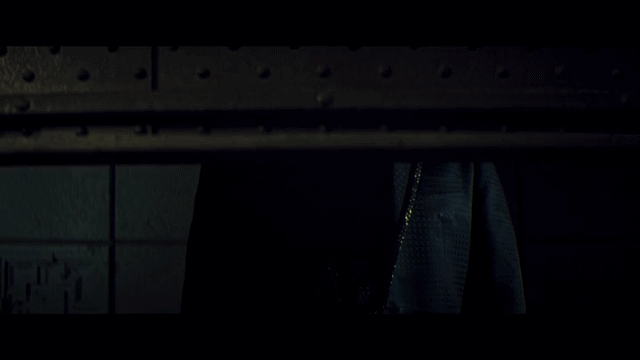
Let's begin with Jack's introduction, where he is literally revealed as the narrator speaks the phrase "the monster who finds himself among them". We join Jack as he enters an unknowingly hostile space, a building full of people who would literally mount his head on the wall if they knew who and what he really was. Jack's introduction to this world is a series of Bayeux-style tapestries showing, among other things, the gory slaughter of his kind. We see him react with a mixture of shock, queasiness, and tamped-down anxiety, which marks him as an outsider. It seems unlikely that the other hunters would be grossed out by the sight of a depiction of their literal jobs.
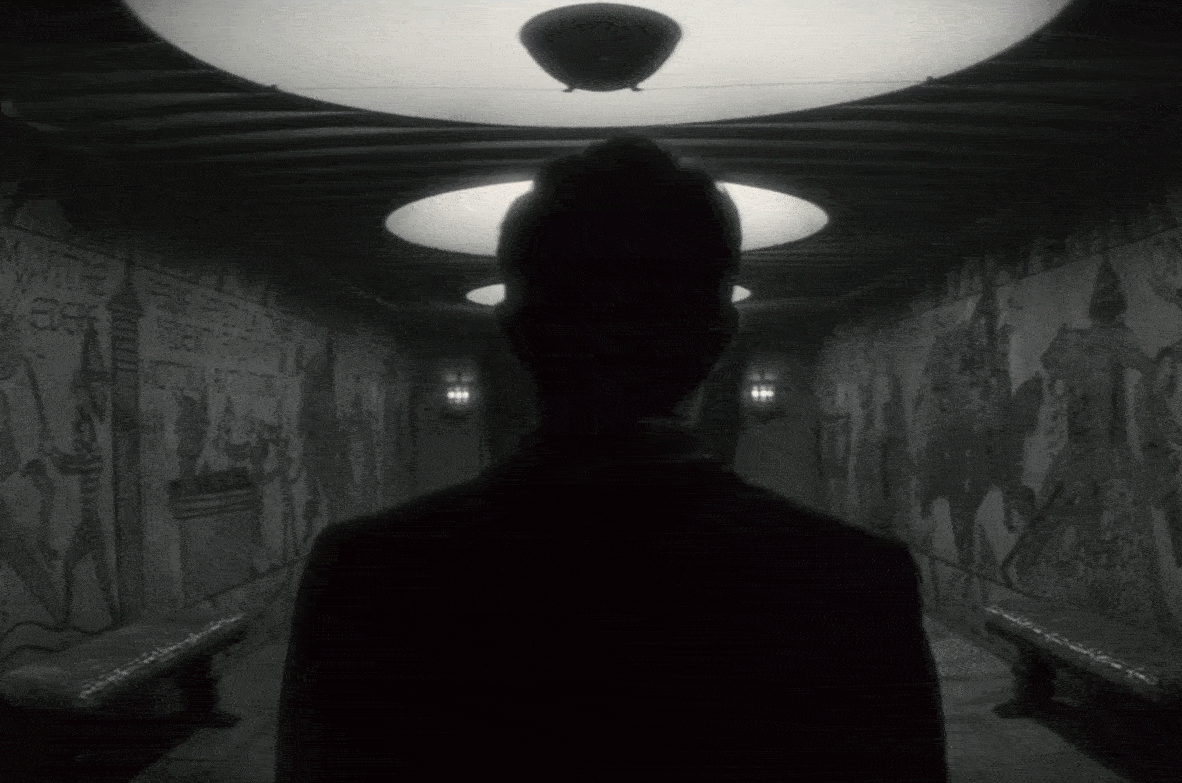
Now, outsider status alone isn't necessarily queercoding, but it often is, especially in monster movies. Jack's reaction is not dissimilar to that of a closeted person entering a homophobic church for some kind of socially expected ritual--and, indeed, Jack has come for a funeral.
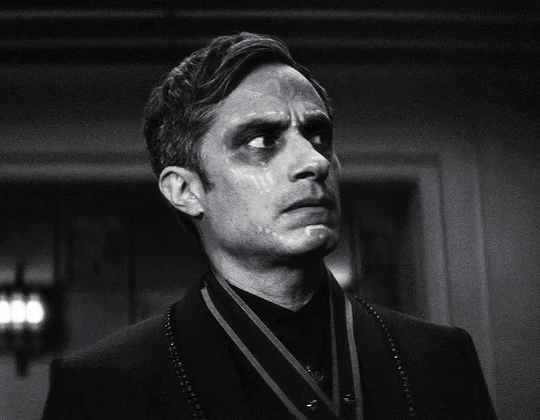
Look at that nervous glance as he walks into the room. He's not comfortable here. He knows he doesn't fit in.
This is a good time to mention Jack's outfit and the way it intersects with what we see of hunter culture. From the leather to the weapons to the heads on the wall, the aesthetic of hunter culture in WBN is hypermasculine, almost to the point of parody. The obsession with imagery of violence and death (the paintings on the walls, the corpse animatronic, the skull bowl) and the hostility to anything perceived as feminine is marked.
Wait. Hostility to anything feminine? Yes, I said that.
There are three characters who are played by female actors: Elsa, Verussa, and ... look, the hunters HAVE names, but I'm just gonna call them Scottish Guy, Asian Guy, Black Guy, and David Bowie. So David Bowie is an adrogynous character played by a female actor who acts as our third not-exactly-a-male character, and it's interesting to me that they're taken more seriously by the other hunters than Elsa is. Elsa, by contrast, is treated with contempt by the other hunters--and the contempt is very specifically gendered. Scottish Guy calls her "lassie" when he threatens her, and Asian Guy says, "Where's the lovely lady's medallion?" with a noticeable leer. They don't take her seriously, not even after Verussa announces she's welcome to participate--and they only brighten up when Verussa reminds them that they're allowed to kill Elsa if they can. That's the response to the only unambiguously female hunter.
Now, you may point out that Verussa doesn't get nearly as much shit from the hunters, but Verussa is explicitly presenting herself as the servant (and sexual partner) of a man. She's also not competing with them for the Bloodstone, nor trying to inherit, even though presumably she has at least as good a claim as Elsa does. She's not trying to enter the hypermasculine realm of hunting, but Elsa is in it, and so Elsa is despised and Verussa is tolerated.
And then there's Jack.
Okay, time for Baby's First Queercoding Element: gender nonconformity. In general, feminine male characters and masculine female characters (something explicitly forbidden by the Hays Code, by the way) are coded as queer. A lot of gay male stereotypes are men doing "womanly" things, like cooking and wearing dresses and having sex with men. The same goes for lesbian stereotypes like short haircuts, manual labor, and having sex with women. Now, obviously ACTUAL queer expression is infinitely more complex, but stereotypes don't do infinite complexity.
So. Is Jack feminine?
Well, he's wearing a gentleman's suit, but by the standards of hunter hypermasculinity, yeah, he's pretty girly. For one thing, he's wearing that suit in a room full of people in combat gear. For another, the suit itself is full of fussy details that mark him as a man who cares a great deal about his appearance, another stereotypically feminine trait. The suit is green, a barely acceptable color in menswear, and it has glittery details like the trim on his lapels. The spinal-column tie is metal as fuck, but it's also a silk tie. He's doing the death-and-gore theme, but making it high fashion. He's even wearing makeup. Granted, it's Día de los Muertos makeup, but it's still pigment on his face for aesthetic purposes. He's also the only hunter who acknowledges, in dialogue, that he has non-white, non-USAmerican heritage--"It's to honor my ancestors." He marks himself (literally) as visibly foreign, even though denigrating foreign masculinity is a big part of American hypermasculinity. He also tries to smile at and befriend every hunter who glares at him--another stereotypically feminine trait that leads to his conversation with Scottish Guy.

Speaking of, that conversation is gay as hell. It's practically flirting, especially the part where Scottish Guy compliments Jack's makeup and then tearfully admits that hunting and living all by himself "gets lonely". And Jack makes this amazing face:
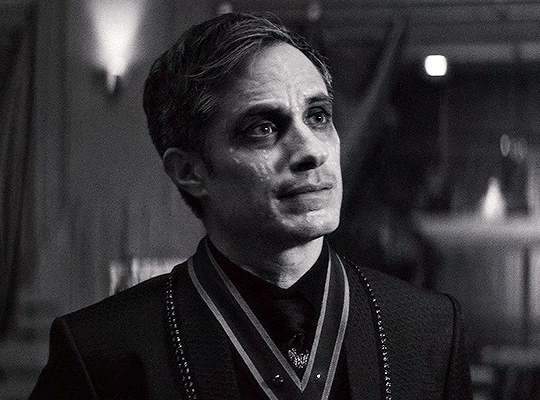
Now, this is me inferring again, but I read this face as a combination of "Aww, that's sweet of you" and "Loneliness caused by hypermasculine self-isolation? I literally have no idea what that's like, but it sounds bad, bro." Perhaps with a soupçon of "Get me out of this conversation aaaaaaa."
So the scene rolls on, and Jack continues to be Bad At Toxic Hypermasculinity. When his top kill count is mentioned, he shrugs it off rather than taking a little bow like the others do. He actually chuckles at Ulysses' joke. He seems mildly interested in Elsa rather than hostile, and amused by her snark rather than threatened by it. He shows fear and worry when he learns Ted is in peril and in pain. The guy really wears his heart on his impeccably tailored sleeve. Notably, none of these traits are bad, per se--they're just more likely to be assigned to feminine characters, and they're given to Jack.
It's important to note the impact of perspective here. Jack is our POV character. If there were to be a hunters' version of this story, Jack would be a sneaky, cowardly, vaguely effeminate villain and Elsa a traitor (or possibly a dimwitted victim seduced by Jack's charms). All of Jack's queercoding would make him a GREAT queercoded villain; it's just that here, he's the protagonist, and a deeply sympathetic one at that, so we miss some of his "unmanly" traits.
All right, let's fast-forward to the maze. We see Jack being clueless and awkward about the drawing of lots, we see some sneaking around, and then we see his first hostile encounter with Elsa, and we get this great exchange:
Jack: I suggest we just pass each other by.
Elsa: ... What?!
Jack, visibly pained by the awkwardness: I suggest we just ... pass each other by.
Jack is uncomfortable with violence. He actively avoids it, talking his way out of trouble when he can and running when he can't. Even Elsa points out how strange he is compared to other hunters, specifically because he avoids violence. He doesn't kill or even hurt anyone in his human form. He doesn't even know how his explosive works--to the point where he asks a woman if SHE knows how to work it.
I'm not saying violence is an inherently masculine trait, but the association of masculinity with a capacity for (and comfort with) violence runs deep in Western culture in general and American culture in particular. It's a huge thing in Mexican culture as well, and yet Jack is actively choosing not to participate in it. He's denying a core part of what would otherwise be his traditional gender role. He later tells Elsa that any "hunting" he does is done by "a part of me that is not me"--a part of himself that he doesn't see as himself. In his eyes, violence is not merely scary or distasteful; it's not part of him at all.
(Compare this to all the ass-kicking Elsa does.)
And then we get to Ted. Buckle up, guys.
Technically, our first introduction to Ted is a distant roar and some screaming, but the moment where we meet him is this:

A jumpscare, followed by a cuddle.
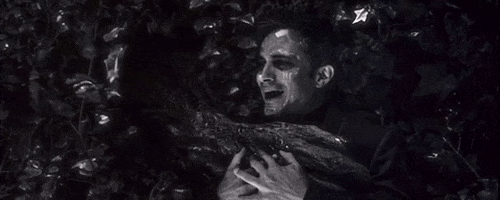
Once again, Jack wears his heart on his sleeve, but more importantly, let me draw your attention to the juxtaposition of Ted's scary grab and Jack's excited snuggling. This relationship is introduced as something scary before being revealed as something sweet--and "scary" is a good description of the portrayal of queercoded couples (who are, remember, usually villains) in classic cinema. All the cinematic language around Ted right up until the grab is telling us to be afraid of him--and then our cinnamon roll of a protagonist starts petting him and greeting him and asking if he's okay. Ted is monstrous and inhuman ... right up until we see him receive affection from another man.
We don't get clear details of Jack's relationship with Ted, but we know that it's a big deal to them--after all, Jack is risking his own life to save the big guy. Jack also describes Ted as "family" and, with a fond eyeroll, a "pain in the ass". Jack implies that he no longer has contact with his family of origin, a common experience for many queer people who are shunned for leaving the closet, but Ted slots neatly into the category of found family. Ted is also, notably, the only close relationship Jack is seen to have, just as Jack is the only close connection Ted is seen to have. The two are physically affectionate (again, cuddling) and emotionally vulnerable in their conversations.
And Elsa, the outsider to their relationship, finds the whole thing bizarre, right down to Ted's name.
Speaking of Elsa, let's talk about Jack's behavior in the crypt and the cage.
In the crypt, Jack displays compassion for someone who has largely been hostile to him (he REALLY wants to fix Elsa's leg), absolute delight when he receives the tiniest signal that she might be sympathetic to him ("It's not in your DNA, then?") and remarkable emotional intelligence (see his speech about families). He also, notably, doesn't hit on Elsa or indicate any sexual interest in her.
He also makes this terrific face when he's handed a skull:
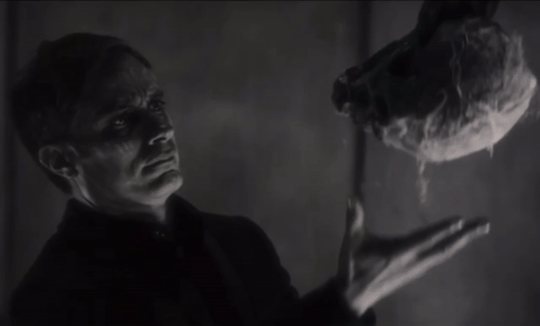
Oh, yeah, that's a big, scary hunter there.
Now, the cage. Jack's response to being put in the cage (and stripped of his jacket, interestingly--little bit of dehumanization there, perhaps) is recognition, followed by attempts at reassuring Elsa, followed by panic. He's arguably more upset than Elsa is, and Elsa thinks she's about to be torn to shreds.

At two points in this story, Jack Russell finds himself trapped in a small space with a beautiful woman and more or less immediately freaks out. It's not the most heterosexual pattern. In fact, it's got strong thematic overtones of queer men being forced into straight relationships by their families, their work, or their society. In a culture that entwines sex and violence, the fact that he's delighted to be grabbed by a male swamp monster but begs for death rather than symbolically do a sex with a woman is noteworthy.
"Symbolically do a sex"? Yeah, the only times the film frames Elsa as anything like a sexual object are the transformation sequence, which is a visual callback to classic sexualized scream queens of yore with her literally in Jack's shadow, and the face-touching scene, where Jack straddles her, their faces almost touch, and then he flees and she sits up with her hair mussed in a dreamy, almost post-orgasmic way.
Michael Giacchino doesn't eroticize violence MUCH, but he's fairly classy about it when he does.
"But wait!" I hear you saying. "What about the sniffing scene? Isn't that eroticized? And it's between Jack and Elsa! Checkmate, liberals!"
First of all, how dare you call me a liberal when my preferred political descriptor is "chaotic good". And second of all ... well, you're HALF right. It IS eroticized...but not because of anything Laura Donnelly or Gael Garcia Bernal is directly doing.
Go watch Elsa's body language during the scene. It's awkward as fuck. She's curled in a ball, knees and elbows out, letting Jack pull on her arm and sniff her hair but not really participating. There's no indication that she wants to be doing this, or even knows what "this" is.
Gael is making a little more of an erotic show about it; in fact, the intensity of his sniffing would probably be an indicator of sexual desire--if he weren't CRYING WHILE HE DOES IT. That's why his voice breaks on "Once."
These are both excellent actors, making very intentional choices with their voices and bodies. They're playing the scene as something that COULD be sexy IF THEY WEREN'T BEING FORCED TO DO IT.
Seriously. There's enough fanfic now that we've all read Jack giving Elsa a leisurely, consensual sniff. You can't tell me Gael and Laura couldn't have made that happen. This is not sexy sniffing. This is angst sniffing. It's just angst sniffing between two beautiful, sympathetic characters who genuinely don't want to hurt each other. It could have been acted and shot in a much sexier way, but it wasn't.
It's also worth noting one last category of queercoding that WBN plays with a lot: dehumanization. A lot of those classic movies played their queercoded characters as specifically less than human, visually aligning them with disliked animals like rats or wolves and often making them literally less human as the story progressed. Even after the Hays Code, monstrous and inhuman queers became a staple of horror movies, especially in the 1980s and 90s as the AIDS crisis convinced a lot of conservative America that LGBTQ people were literal plague rats. There were proposals to tattoo HIV-positive people to identify them, to round them up into camps, to shut HIV-positive kids out of schools because those kids were implicitly queer and therefore not deserving of human rights like an education.
WBN, with its werewolf POV, pushes back on this trope in some specific ways. Jack's line about being "still a human" is an obvious one, as well as his explanation of "systems" to keep other people safe. (It was common during the AIDS crisis for queer people to be fired from their jobs if they were outed because they were considered an AIDS risk to their coworkers--even if they were, say, an office worker who didn't have any contact with other people's bodily fluids. There were conspiracy theories about AIDS spreading through shared soda cans. Those paper seat protectors in public bathrooms came about because of fears that AIDS could spread via toilet seats. So imagine a gay man trying to explain that he's not a threat to his officemates, and you'll see the parallels to Jack trying to reassure Elsa.)
Most notable, however, is how Elsa survives the wolf. She's safe because she maintains eye contact (implicitly acknowledging her and Jack's shared humanity--she literally refuses to stop seeing him) and because he remembers her scent (she becomes a part of his world as he becomes part of hers). Elsa is rewarded, both with her life and with her inheritance, for treating Jack and Ted like human beings when the world around her regards them as abominations.
Elsa is an ally. She's ally-coded. She can also be read as a love interest for Jack, but she consistently acts in support of his relationship with Ted as well.
In Part 3, we're going to talk about the crowning moment of queercoding in WBN. That's right--it's time to learn about coffee in the woods, the gay jukebox, and the Friends of Dorothy.
#werewolf by night#werewolf by night meta#queer coding#jack russell#ted sallis#elsa bloodstone#attempts at formal analysis#what am i even doing#i hope someone actually likes this#jfc this is so much longer than i planned#nobody get mad at me please#i am literally just pointing at the thing we all like and saying “look a good bit”#long post#media studies and writing hacks with kat
23 notes
·
View notes
Photo

My Top 10 Favorite Anime Heroines by DarkChild316
Being a hero isn’t easy, but someone’s gotta do it! And these ladies have shown to be just as capable as their male counterparts. Now I’ve already done a list showing everyone “My Top 10 Anime Villainesses”, but I figured: “Hey the good girls deserve some love too,” so I decided to give you guys my list of my Favorite Anime Heroines as well. So, with that in mind, here’s my list:
#10. Saeko Busujima (Highschool of the Dead): This is an anime that will give you plenty of two things in abundance…boobs and zombies! While it may seem like your run-of-the-mill apocalyptic fanservice anime, among the well-proportioned ladies is this kendo warrior who’s more than capable of holding her own against any foe and would fit right in with even the most old-school samurai-themed anime. When the dead start to walking most of the cast usually reach for a form of firearms, not this lady who prefers to slice apart the undead with the greatest of discipline and precision, whether it be with her signature bokken or her deadly Murata-tou sword. There’s no denying that Saeko’s the ideal companion we’d want on our side for a zombie apocalypse.
#9. Touka Kirishima (Tokyo Ghoul): Living as a ghoul isn’t easy, especially when you’re trying your damnest to retain what little remains of your humanity. Starting off as a cold, yet collected individual, Touka found shelter in both the horrors of her dark past and her constant hunger for flesh in her day job at a café as a waitress which serves other ghouls and as a hangout stop for ghouls. While she grew warmer as her relationship with one Ken Kaneki grew, she’s not without her bestial side, possessing an abject hatred for the CCG after they killed her parents. In a series where everyone seems to be on the edge of insanity and turning into a rampaging, bloodthirsty monster, Touka is one of the few characters genuinely fighting for a chance at a peaceful life.
#8. Riza Hawkeye (Fullmetal Alchemist): Lieutenant Riza Hawkeye is undoubtedly one of the best female anime characters of all time and for good reason, she is truly the perfect soldier. As both an Amestrian State Military’s officer as well as Colonel Roy Mustang’s bodyguard, Riza Hawkeye is a dangerous sharpshooter and firearms specialist. From the outside she can seem strict and even a little cold, but those close to her know that there’s much more to her than her strict no-nonsense attitude, including a courteous nature in the presence of her allies and a desire to protect those she holds dear. Beneath the strict persona is a kind soul who understands the difficulty of carrying a heavy burden and let’s not forget…she’s a true badass in every sense o the word!
#7. Erza Scarlett (Fairy Tail): She went from child slave to arguably one of the strongest mages in all of Fiore. All while battling against S-Class mages, terrifying demons, and even her own psychotic mother, now that’s dedication folks! Forced by her possessed childhood friend to build the Tower of Heaven, she manages to escape her captivity and make her way to Fairy Tail, where she would soon rise to become one of Fairy Tail’s youngest S-Class mages and one of the most truly badass fighters in Fairy Tail’s ranks. With her magical ability known as Re-Quip, she has an unlimited number of weapons and armors at her disposal, each possessing their own devastating abilities. She’s a stoic warrior with a soft heat and a dark past, and you can bet your ass that she’ll fight to defend her Nakama to the bitter end.
#6. Ryuko Matoi (Kill la Kill): Her choice of armor may be a bit on the revealing side but going against this rebel isn’t the smartest idea if you value your life. You’re not likely to find a more stubborn soul in this absolutely whacky series and trust me…NONE of these characters are on the subtle side of things. In search of her father’s killer, Ryuko takes up the sentient life-fiber uniform Senketsu, and openly battles the dictatorship that is the Student Council. Stubborn as hell, Ryuko will always stand up to anyone who gets in her way, no matter how badly the odds are stacked against her. How can you not love someone with that kind of drive!
#5. Saber (Fate/stay night): Before she became a hero in the endless Holy Grail Wars, Saber was actually Artoria Pendragon, known throughout history as King Arthur, the mythical King who united Britain. As the Saber-class servant, Artoria generally tries to hide her identity in battle by using an invisible sword. When pushed, she can brandish Excalibur instead though, a sword she wields with unmatched skill and can do long-range attacks as easily as close-range. With her holy sword, and her “Mana Burst” ability, she is one of the most powerful Servants. Saber is loved by fans worldwide for good reason: she is kind, valiant, and fierce, all traits that make for one divine heroine. None would mind putting the fate of the world in this blonde beauty's hands.
#4. Mikasa Ackerman (Attack on Titan): Attack on Titan's Mikasa is one of those reserved, stoic characters who doesn't speak very often and seems to be stuck in her own head. After all the trauma she’s experienced living under the looming terror of Titans and the carnage she witnessed while part of the Survey Corps, not to mention the brutal murder of her biological parents by criminals, it would be difficult to come out unscathed. Perhaps it’s endurance that is one of Mikasa’s most relatable traits. Despite her often-cynical comments about the world around her, she manages to retain her humanity. Mikasa herself said, “This world is cruel. And yet... so beautiful.” The stereotypical boy-saves-girl gender roles that play out in media are also very much reversed when it comes to her relationship with Eren, which is a refreshing and welcome change of pace to see, though her protectiveness of him seems a little unhealthy at times. On top of everything mentioned, she’s also totally ripped.
#3. Asuka Langley Soryu (Neon Genesis Evangelion): I just couldn’t leave out Neon Genesis Evangelion’s Asuka Langey Soryu from this list of awesome female protagonists. Asuka is a classic anime heroine and remains beloved by fans of the show to this day. Asuka is an American teenage girl who serves as an Eva pilot for the Evangelion Project and pilots the Evangelion Unit-02. Asuka was raised in Germany and often swears in German. She was a child prodigy with a college degree at only fourteen years old, but definitely has her human flaws. She has a temper and is obsessed with being the best at everything she does. Despite these flaws, Asuka is hilarious in her own way and has the kind of confidence and pride you rarely see in a young girl. She knows she can do her job well and isn't afraid to tell you about it. Asuka is relatable in that she is stubborn and often has a hard time properly expressing her feelings and vulnerability to others. Her eventual nervous breakdown shines a light on her humanity-- she is not a perfect person and she is still a child forced to do a job that no child should be forced to do.
#2. Motoko Kusanagi (Ghost in the Shell): Major Motoko Kusanagi is one of the primary protagonists of the popular Ghost in the Shell franchise of manga, films, and animated series. Motoko is a cyborg who works as a field commander for Public Security Section 9 on the Japanese National Public Safety Commission. Motoko is a very physically strong and incredibly intellectual who that is quick-witted and an excellent hacker. But put a firearm in her hand, and she’s especially deadly. As a child, Motoko was comatose following an airplane accident. After her health began to steadily decline, her consciousness was put into a "full-body prosthesis,” an augmented-cybernetic human body. Motoko causes us to question exactly what makes us human. She is an emotional, stoic, strong woman who fights for the citizens she protects, yet she lives inside an artificial body. But her greatest use is as a platform to speak on the nature of humanity in a technological age. She's a human mind that has been stuck in an artificial body since childhood, and her life and trials bring up the age-old question, "What does it mean to be human?"
#1. Usagi Tsukino (Sailor Moon): You really can’t have a list of awesome female protagonists without including everyone’s favorite schoolgirl superhero: Usagi Tsukino from Sailor Moon. Usagi is the embodiment of an empowering female in anime in her fearless display of conventional femininity without any implied weakness. Usagi is your typical teenage girl who is all about her friends, food, and cute things, while simultaneously being a badass heroine who cleanses the streets of evil. In the original manga and anime, Usagi was portrayed as reluctant to be a superhero and would often run away from fights and be a crybaby. However, through her careful character development, Usagi becomes a brave, reliable, and confident person who cares deeply for her friends. She becomes a better version of herself without stereotypically “shedding” her girliness. Instead, her femininity becomes a defining feature of hers, deconstructing the idea that being girly makes you weak. On the contrary, Usagi’s girliness makes her funny, relatable, and a good role model for young girls. Usagi set the template for a generation of female heroines for generations to come, and it’s for that reason why she’s well-deserving of my #1 ranking on my list.
So that's my updated list, what did you guys think about it? Love it, hated it? Go on and tell me what you think and let me know who your favorite anime heroines are. See you soon!
Deviantart: https://www.deviantart.com/darkchild316
#saeko busujima#highschool of the dead#touka kirishima#tokyo ghoul#riza hawkeye#Fullmetal Alchemist#erza scarlet#fairy tail#ryuko matoi#kill la kill#saber fate#fate stay night#mikasa ackerman#attack on titan#asuka langley soryu#neon genesis evangelion#motoko kusanagi#Ghost In The Shell#usagi tsukino#sailor moon
53 notes
·
View notes
Text
"FanFiction in my 25yrs of interacting in fandom and writing has never been about fan service but about making a million different stories about beloved characters."
Name/Handle/Alias
drnucleus
About how long would you say you’ve been rooting for Reylo?
December 2015 as soon as I walked out of the theater.
What did you think of the way Rise of Skywalker handled Rey and Kylo’s relationship?
They backtracked a lot of the emotional vulnerability of TLJ for needless drama and miscommunication tropes where neither party addresses their feelings until dire moments. Then it also backtracks on their chemistry. Adam and Daisy have incredible chemistry yet they put his mask back on to distance them. The dark side struggle for him has always felt real but Rey’s felt contrived and forced. Like they didn’t know how else to make her drawn to the dark when Rian Johnson did it simply because of her selfishly clinging to the idea of her parents instead of that cruel reality. Not to mention the absurdity of “they sold you to save you” what the hell was that?? Don’t even get me started about how sidelined Ben was in the latter half. The sexual tension wasn’t there like it was in TLJ, nor the vulnerability or softness until he shows up on Exegol. Even then it felt like they were trying to distinguish Ben Solo and Kylo Ren instead of him owning what he did and choosing to be better for it. Instead they gave him a mental rewrite with a memory of his worst deed? Shameful tbh.
Do you think the film understood why you, and other people, felt like Rey and Kylo had something together? Did it get their chemistry?
Nope not at all. See above rant in last question for details!
What about the handling of Kylo’s redemption? Was it something you had to think through in your stories?
I wanted the big bad to be Hux tbh. The idea that Ben would have to overcome a monster of his own making in the First Order would have been great. Make Hux try to resurrect Palpatine by manipulating force sensitive troopers to open a portal to the World Between Worlds. Or if you’re gonna bring back Palpatine, make him actually as deep of a villain has he was in the prequels and OT and not this shell of ridiculousness that seems aimless in end goal.
What did you think of where Rey landed at the end? There had been a lot of excitement around Star Wars having a female protagonist. Do you think she lived up to the promise of her character?
No. She basically just 360’d and is back to TFA Rey. She has no emotional growth because she’s never given a moment to grieve and be emotional about the horror she just went through. Not even just her soulmate dying but she also died and killed her only living biological relative with no hesitation?! For someone who is all about wanting family and belonging she was never once tempted to even just succumb to what Palpatine wanted? She had to be manipulated into it as a heroic act to save her found family? I was so glad Ben showed up and was able to give her an out because that was a stupid plot point.
There’s criticism of the movie that argues it’s akin to “fan fiction” and that is has too much fan service. As fans and fan-fiction writers, how do you react to that?
FanFiction in my 25yrs of interacting in fandom and writing has never been about fan service but about making a million different stories about beloved characters. And tbh I have seen hundreds of post TLJ fanfics that had better narrative beats and plot than TROS and some didn’t even have a Reylo endgame and were still vastly more satisfying.
Are you still writing any Star Wars fanfic? Tell us about it! (Don't forget your Ao3 handle!)
I do. I write Bedroom Hymns, StarMan. Both are modern AU. One is smut heavy and has healthy emotional and BDSM relationships. The second is a Reylo AU of The Martian. I am beginning to break into canon verse writing a postTros fix-it Fic.
Thank you @drnucleus you can find their writing here: https://archiveofourown.org/users/drnucleus/pseuds/drnucleus
2 notes
·
View notes